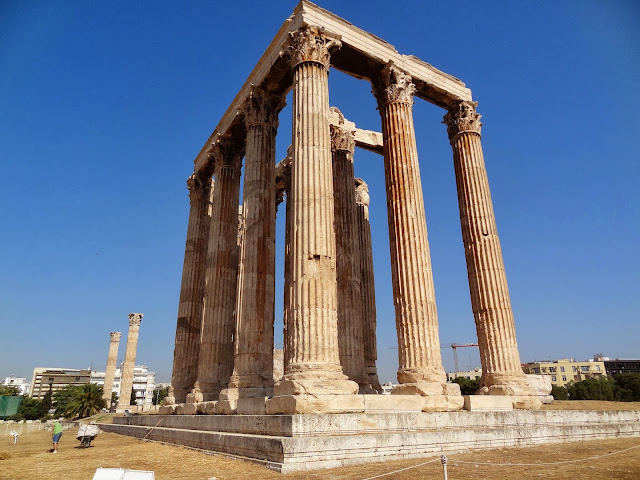You can tell it's basically just an area of dusty land with a handful of columns. Right?
Um...not exactly.
This happens to be the second of two temples constructed in dedication to Zeus, the king of the Olympian gods. Construction on this second temple began in 520 B.C. but work was abandoned and restarted under several regimes and due to several battles over the years, and was not completed and formally dedicated until 132 A.D. By this time, Athens was under the rule of the Roman Emporer Hadrian, who built the Arch of Hadrian at the entrance to the temple grounds.
(credit: Wikipedia)
The design was also changed a few times during construction. The final plan consisted of 3 rows of 8 columns across the front and back, and a double row of 20 columns on the sides, for a total of 104 columns.

In the 3rd century A.D. and periods after, the structure of the temple, was pillaged and its marble and other building materials were harvested for for use in construction all over Athens.
Columns are of the Corinthian order (the first time this order was used on the exterior of a major temple - there's your trivia for today!), standing 17 meters (55.5 feet) high and 2 meters (6.5 feet) in diameter.
It's really hard to get an idea of how large this temple ruin really is. So here's a picture of me standing in front of the columns, for scale. Huge!
Walking those grounds, I openly wondered to Chris why we (people in general) allow something so majestic and beautiful as this temple to be pillaged and ultimately stand in ruins. Our discussions brought me to the realization that the lack of preservation is largely due to the changes in religious and political majorities in the region over the years. When the temple was built, the Olympian gods were very important to the people of Athens. In later years, Christianity reigned, and worship of Roman and Greek gods was prohibited. Without that societal influence (wow, I'm using some big words!), the temple lost its significance. An interesting phenomenon, huh? Who knew centuries ago that people of all religious affiliations of the 21st century would explore these grounds in wonder and amazement, just of the art and architecture involved in the construction. To us, the religious and political connotations do not factor into our sense of wonder. However, I think the amount of time that has passed does play a role. I can't imagine looking at a temple honoring, say, Adolf Hitler, with the same level of amazement and appreciation, regardless of its artistic or architectural value. Interesting to think about, right?
That's the acropolis beyond the Temple of Zeus (I'd like to go there one day...). It sure looks like it is right there, doesn't it. You could reach out and touch it. It's actually about a half a mile away, as the crow flies.
At the Temple of Olympian Zeus today, 15 columns remain standing, and a 16th one is lying across the ground. This column was toppled by the strong wind of an 1852 storm. Here, you can see that toppled column.
After our visit to the Olympian Temple of Zeus, it was back to the bus, and we were headed to our next stop, which was the "pinnacle" of our city tour.





